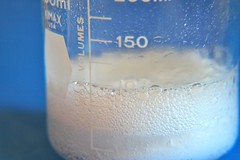AP Biology - Energy & Enzymes Flashcards
Terms : Hide Images [1]
| 9783160040 | catabolic pathways | Series of reactions that release energy by breaking down complex molecules into simpler compounds. |  | 0 |
| 9783160041 | anabolic pathways | Series of reactions that consume energy to build complicated molecules from simpler ones. |  | 1 |
| 9783160045 | potential energy | Stored energy. |  | 2 |
| 9783160050 | endergonic reaction | Reaction that absorbs free energy from its surroundings. |  | 3 |
| 9783160051 | exergonic reaction | Reaction that proceeds with a net release of free energy. |  | 4 |
| 9783160054 | phosphorylation | The metabolic process of introducing a phosphate group into an organic molecule. |  | 5 |
| 9783160056 | enzyme | Protein that speeds up reactions. Typically end in "ase" (ex. Peroxidase, Lipase) |  | 6 |
| 9783160057 | activation energy | The amount of energy needed to push the reactants over an energy barrier. |  | 7 |
| 9783160058 | enzyme-substrate complex | When an enzyme binds to its substrate, it forms: |  | 8 |
| 9783160059 | active site | A pocket or groove on the surface of the enzyme where a substrate can bind. |  | 9 |
| 9783160060 | induced fit model | States that the enzyme and substrate undergo conformational changes to interact fully with one another (as opposed to "Lock & Key" |  | 10 |
| 9783160061 | cofactor | Inorganic metal ion helpers that may be bound tightly to the enzyme as a permanent resident, or may bind loosely and reversibly along with the substrate. Iron is an example. |  | 11 |
| 9783160062 | coenzyme | Non-protein Organic helpers that may be bound tightly to the enzyme as a permanent resident, or may bind loosely and reversibly along with the substrate. Most vitamins function this way. |  | 12 |
| 9783160065 | feedback inhibition/negative feedback | A metabolic pathway is switched off by the inhibitory binding of its end product to an enzyme that acts early in the pathway. |  | 13 |
| 9783160066 | saturated enzyme | Describes an enzyme's maximum activity when every active site is being used. | 14 | |
| 9783160067 | Chemical Energy | Potential energy trapped in molecular bonds. |  | 15 |
| 9783160072 | Competitive inhibition | substance that resembles the normal substrate competes with the substrate for the active site which can be overcome by adding more substrate |  | 16 |
| 9783160073 | Noncompetitive inhibitor | a chemical that binds to an enzyme but not in the active site. This chemical will change the shape of the enzyme so substrate can no longer fit active site |  | 17 |
| 9783160074 | substrate | the substance an enzyme catalyzes, changes. |  | 18 |
| 9783160075 | exothermic reaction | a chemical reaction where energy is given off, so that the products have less energy than the reactants. |  | 19 |
| 9783160076 | endothermic reaction | a chemical reaction where energy is taken in, so that the products have more energy than the reactants. |  | 20 |
| 9783160086 | Denature | Characteristic of proteins; a change in shape that stops the protein from functioning. |  | 21 |
| 9783160087 | Allosteric | __________ regulation of enzyme occurs when a molecule binds to an enzyme changing the protein's shape |  | 22 |
| 9783160097 | Protein Kinases | enzymes that reversibly activate or inactivate other proteins by adding phosphate groups to (phosphorylating) them | 23 | |
| 9783160098 | pH | After looking at the graph the enzyme activity of the the three different enzymes is being regulated by what variable |  | 24 |
| 9783160099 | Temperature | After looking at the shape of graph the enzyme activity of this enzymes is being regulated by what variable: |  | 25 |
| 9783160101 | Metabolism | The totality of an organism's chemical reaction | 26 |
